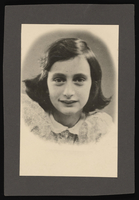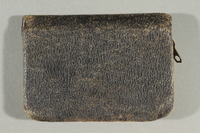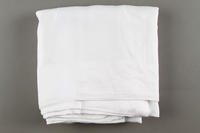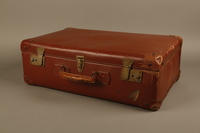Overview
- Description
- Recorded greetings from Otto and Fritzi Frank to Ryan Cooper on the occasion of the Jewish New Year. They provide updates about family members in English. They reference donating photocopies of Anne's diary to the city of Amsterdam and visitors to Anne Frank House.
- Credit
- United States Holocaust Memorial Museum, Gift of Ryan M. Cooper
- Format
- Audiocassette
Physical Details
- Language
- English
Rights & Restrictions
- Conditions on Access
- You do not require further permission from the Museum to access this archival media.
- Copyright
- Anne Frank Fonds
- Conditions on Use
- The Anne Frank Fonds has asserted copyright over all materials created by Otto Frank until 60 years after his death. Any requests to republish these materials should be directed to the Anne Frank Fonds.
Administrative Notes
- Legal Status
- Permanent Collection
- Recorded Sound Provenance
- Ryan M. Cooper donated his papers to the United States Holocaust Memorial Museum in 2018.
- Recorded Sound Source
- Mr. Ryan M. Cooper
- Record last modified:
- 2024-02-21 07:27:30
- This page:
- https://collections.ushmm.org/search/catalog/irn712042
Download & Licensing
- Request Copy
- See Rights and Restrictions
- Terms of Use
- This record is digitized but cannot be downloaded online.
In-Person Research
- Available for Research
- Plan a Research Visit
Contact Us
Also in Ryan M. Cooper collection
The collection consists of table linens, a mustard pot, coin purse, suitcase, book, correspondence, newspaper clippings, photographs, documents, and an audio recording relating to the experiences of Otto Frank, Edith Frank, Fritzi Frank, Herbert Frank, Miep Gies, Jan Gies, Bep Voskuijl, and Victor Kluger in Frankfurt, Germany, Amsterdam, Netherlands, and Basel, Switzerland, before, during, and after the Holocaust.
Date: after 1800-1980

Ryan M. Cooper papers
Document
The Ryan M. Cooper papers consist of photographs of Anne Frank and her diary as well as correspondence to Ryan Cooper from Otto and Fritzi Frank, Miep Gies, Herbert Frank, Victor Kugler, and Bep Voskuijl. Anne Frank photographs include two items Otto Frank gave to Ryan Cooper. One is a photograph of Anne Frank at age 10 mounted on black photograph album paper. The image was cut out of one of the Frank family photo albums, and Frank gave it to Cooper in 1977. The other item is a printer’s mechanical paste-up of photographs of various foreign editions of Anne’s diary, a sketch of the outside of 263 Prinsengracht, and small pencil notes in German believed to be written by Otto Frank. Frank gave this item to Cooper in 1973. Otto Frank materials include letters and cards from Otto Frank and his second wife Elfriede “Fritzi” Frank to Ryan Cooper. The letters and cards include advice to Cooper about religion, work, and romance; information about the Anne Frank House and Anne Frank Foundation; planning for Cooper’s trips to Europe; news about the couple’s lives, travels, and health; and thoughts about Anne Frank’s legacy. The letters dated October 15, 1975; March 29, 1977; July 22, 1990; and February 12, 1992 are accompanied by enclosures including a photograph and two poems, a clipping, an Anne Frank commemorative postage stamp, and two additional photographs. Miep Gies materials include letters and greeting cards from Miep Gies conveying warm greetings, advice, and news about her life. This series also includes photographs of Gies, information about her cremation, and a copy of one of her speeches about Anne Frank. The collection includes additional correspondence to Cooper from Otto Frank’s younger brother Herbert Frank as well as Victor and Lucy Kugler and Bep Voskuijl, who helped conceal the Frank family in hiding. The letters and cards convey greetings, travel and health news, and their thoughts on Anne’s legacy.

Coin purse owned by Otto Frank
Object
Change purse owned by Otto Frank. Otto was a German Jewish businessman who immigrated to Amsterdam, Netherlands, with his wife, Edith, and daughters, Margot and Anne. Germany invaded the Netherlands on May 10, 1940. Under German occupation, antisemitic restrictions were enforced, and Otto set up a hiding place in the attic of his business. The family moved into their hidden rooms on July 6, 1942, and were later joined by four others. Otto’s most trusted employees, including Miep and Jan Gies, immediately agreed to help them, at great risk to their own safety. Otto’s most trusted employees, including Miep and Jan Gies, immediately agreed to help them, at great risk to their own safety. While in hiding, Anne documented her thoughts and the group’s daily activities in a diary. In late March 1944, she began editing her diary and notebooks, with the goal of publishing it after the war. After two years, the hiding place was raided on August 4, 1944. The group was arrested and imprisoned in Westerbork transit camp. On September 3, they were all deported to Auschwitz-Birkenau killing center in German-occupied Poland, where Otto was assigned to forced labor. In January 1945, Auschwitz was evacuated in advance of the Soviet arrival. Prisoners able to walk were sent on a forced march. However, Otto was in the sick barracks at the time, ill and underweight. Soviet forces entered the camp on January 27, 1945, and Otto was nursed back to health. Otto was the only member of the hidden group to survive the Holocaust. He returned to Amsterdam on June 3, 1945, and moved in with Miep and Jan Gies. Miep gave Otto some personal possessions, including Anne’s diary, which she had saved. He found a publisher for the diary, which became well known worldwide. Otto devoted the rest of his life to fighting for human rights and organized international youth conferences.

Pewter mustard pot owned by Otto Frank
Object
Pewter mustard pot owned by the Frank family. Otto Frank was one of three children born to Michael and Alice Frank in Frankfurt am Main, Germany. He had three siblings, Robert, Herbert, and Helene. Michael had founded a family banking business, which his wife and sons took over after his death in 1909. Helene moved to Basel, Switzerland, with her husband in 1931, and Herbert immigrated to France in 1932. After Adolf Hitler was appointed chancellor of Germany in January 1933, authorities quickly began suppressing the rights and personal freedoms of Jews, and boycotting their businesses. Shortly thereafter, Robert immigrated to England, and Otto immigrated to the Netherlands with his wife, Edith, and two daughters, Anne and Margot. In October 1933, Alice joined Helene in Basel. The Netherlands was invaded by Germany in May 1940, and Otto’s family went into hiding in July 1942. They were discovered and arrested in August 1944, and deported to Auschwitz-Birkenau killing center in German-occupied Poland. Otto was the only one of the four to survive the Holocaust, and returned to Amsterdam in June 1945. While rebuilding his life, Otto married Fritzi Geireinger, a former neighbor whose daughter he had met while in Auschwitz. Otto joined the rest of his family in Basel in 1952, and married Fritzi the following year. Otto published the diary his daughter, Anne, had used to document their time in hiding, and devoted the rest of his life to fighting for human rights and organized international youth conferences.

Monogrammed tablecloth owned by Otto and Edith Frank
Object
Cotton tablecloth, embroidered with the initials of Otto and Edith Frank, gifted to them for their wedding on May 8, 1925. Otto and Edith had two daughters, Margot and Anne, and lived in Frankfurt, Germany. After Adolf Hitler was appointed chancellor of Germany in January 1933, authorities quickly began suppressing the rights and personal freedoms of Jews, and boycotting their businesses. Germany invaded the Netherlands on May 10, 1940, and under occupation, the Netherlands became subject to the Nuremburg laws. As restrictions continued to tighten, and antisemitism grew, Otto set up a hiding place in the attic of his business. The family moved into their hidden rooms on July 6, 1942, and were later joined by four others. Otto’s most trusted employees, including Miep and Jan Gies, immediately agreed to help them, at great risk to their own safety. The group was discovered and arrested in August 1944, and deported to Auschwitz-Birkenau killing center in German-occupied Poland. Margot and Anne were transferred to Bergen-Belsen concentration camp in Germany, where they both died from typhus in March 1945. Edith died in Birkenau on January 6, 1945. Otto was the only one of the group to survive the Holocaust, and he returned to Amsterdam in June 1945. While rebuilding his life, Otto contacted Fritzi Geireinger, a former neighbor whose daughter, Eva (later Schloss), he had met while in Auschwitz. Otto joined the rest of his family in Basel, Switzerland, in 1952, and married Fritzi the following year. Otto devoted the rest of his life to fighting for human rights and organized international youth conferences.

Monogrammed napkin owned by Otto and Edith Frank
Object
Cotton napkin, embroidered with the initials of Otto and Edith Frank, gifted to them for their wedding on May 8, 1925. Otto and Edith had two daughters, Margot and Anne, and lived in Frankfurt, Germany. After Adolf Hitler was appointed chancellor of Germany in January 1933, authorities quickly began suppressing the rights and personal freedoms of Jews, and boycotting their businesses. Germany invaded the Netherlands on May 10, 1940, and under occupation, the Netherlands became subject to the Nuremburg laws. As restrictions continued to tighten, and antisemitism grew, Otto set up a hiding place in the attic of his business. The family moved into their hidden rooms on July 6, 1942, and were later joined by four others. Otto’s most trusted employees, including Miep and Jan Gies, immediately agreed to help them, at great risk to their own safety. The group was discovered and arrested in August 1944, and deported to Auschwitz-Birkenau killing center in German-occupied Poland. Margot and Anne were transferred to Bergen-Belsen concentration camp in Germany, where they both died from typhus in March 1945. Edith died in Birkenau on January 6, 1945. Otto was the only one of the group to survive the Holocaust, and he returned to Amsterdam in June 1945. While rebuilding his life, Otto contacted Fritzi Geireinger, a former neighbor whose daughter, Eva (later Schloss), he had met while in Auschwitz. Otto joined the rest of his family in Basel, Switzerland, in 1952, and married Fritzi the following year. Otto devoted the rest of his life to fighting for human rights and organized international youth conferences.

Vulcanized fiber suitcase owned by a member of the Frank family
Object
Vulcanized fiber suitcase owned by a member of the Frank family, likely Herbert. Herbert Frank was one of three children born to Michael and Alice Frank in Frankfurt am Main, Germany. He had three siblings, Robert, Otto, and Helene. Michael had founded a family banking business, which his wife and sons took over after his death in 1909. Helene moved to Basel, Switzerland, with her husband in 1931, and Herbert immigrated to France in 1932. After Adolf Hitler was appointed chancellor of Germany in January 1933, authorities quickly began suppressing the rights and personal freedoms of Jews, and boycotting their businesses. Shortly thereafter, Otto immigrated to the Netherlands with his wife and two daughters, and Robert immigrated to England. In October 1933, Alice joined her daughter in Basel. In summer 1942, German occupation authorities in France began mass arrests, internment, and deportation of Jews. Herbert was arrested and held in Gurs internment camp in southwestern France. He decided to immigrate to Switzerland, arriving on October 15, 1942. Otto was in hiding with his wife and daughters for two years, until they were discovered, arrested, and deported to Auschwitz-Birkenau killing center in August 1944. Otto was the only member of his family to survive the camps, and returned to Amsterdam after the war. Herbert lived in Switzerland until 1945, when he returned to Paris. Otto immigrated to Switzerland in 1952. Herbert moved to Basel permanently in 1955, and remained close with his family until his death.
First edition of Anne Frank’s Het Achterhuis given to a Dutch couple
Object
One of two copies of the first edition of Anne Frank’s “Het Achterhuis” (“The Secret Annex”), given to Miep and Jan Gies by Anne’s father, Otto Frank. The book includes the original dust jacket and protective clamshell case, and was one of 1500 copies printed in the first run. Anne Frank was a German Jewish girl who immigrated to Amsterdam, Netherlands, with her parents, Otto and Edith, and older sister, Margot. Germany invaded the Netherlands on May 10, 1940. Under German occupation, antisemitic restrictions were enforced, and Otto set up a hiding place in the attic of his business. The family moved into their hidden rooms on July 6, 1942, and were later joined by four others. Otto’s most trusted employees, including Miep and Jan Gies, immediately agreed to help them, at great risk to their own safety. While in hiding, Anne documented her thoughts and the group’s daily activities in a diary. In late March 1944, she began editing her diary and notebooks, with the goal of publishing it after the war. After two years, the hiding place was raided on August 4, 1944. The group was arrested and imprisoned in Westerbork transit camp. On September 3, they were all deported to Auschwitz-Birkenau killing center in German-occupied Poland. In late October 1944, Anne and Margot were transferred to Bergen-Belsen concentration camp in Germany. Both Anne and Margot died of typhus in March 1945. Anne’s father, Otto, was the only member of the group to survive the Holocaust. He returned to Amsterdam on June 3, 1945, and moved in with Miep and Jan Gies. After learning of Anne’s death, Miep gave Otto Anne’s diary, notebooks, and papers that she had salvaged from the annex in 1944. Two years after the war, Otto found a publisher for the diary, and the first edition, titled “Het Achterhuis,” was released in the summer of 1948.



